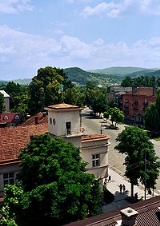
Svaliava
Encyclopedia
Svaliava is a city
located on the Latorytsia River
in the Zakarpattia Oblast
(province
) in western Ukraine
. It is the administrative center of the Svaliava Raion
(district
).
After the second World War a concentration camp was working near the town. Hungarian and German-born civilians (born between 1896 and 1926) were carried off by Soviet forces to the camp purely on the basis of their nationality. They were ordered to report for "malenkij robot" (a corrupted Russian for "small work"), but most of them – more than 10 thousands deportees were killed in the camp.
City
A city is a relatively large and permanent settlement. Although there is no agreement on how a city is distinguished from a town within general English language meanings, many cities have a particular administrative, legal, or historical status based on local law.For example, in the U.S...
located on the Latorytsia River
Latorica River
Latorica is a river in the watershed of the Danube. Its source is in the Ukrainian Carpathians , near the village Nizhny Vorota. It flows from Ukraine to Slovakia , 188 km in total and west through the towns Svaliava, Mukachevo, Solomonovo, Chop and Velke Kapusany. The watershed is 3,130 km²...
in the Zakarpattia Oblast
Zakarpattia Oblast
The Zakarpattia Oblast is an administrative oblast located in southwestern Ukraine. Its administrative center is the city of Uzhhorod...
(province
Oblast
Oblast is a type of administrative division in Slavic countries, including some countries of the former Soviet Union. The word "oblast" is a loanword in English, but it is nevertheless often translated as "area", "zone", "province", or "region"...
) in western Ukraine
Ukraine
Ukraine is a country in Eastern Europe. It has an area of 603,628 km², making it the second largest contiguous country on the European continent, after Russia...
. It is the administrative center of the Svaliava Raion
Svaliava Raion
Svaliava Raion is a raion in Zakarpattia Oblast in western Ukraine. Its administrative center is Svaliava. It has a population of 54 869.-External links:*...
(district
Raion
A raion is a type of administrative unit of several post-Soviet countries. The term, which is from French rayon 'honeycomb, department,' describes both a type of a subnational entity and a division of a city, and is commonly translated in English as "district"...
).
Demographics
In 2001, the population included: http://www.ukrcensus.gov.ua/eng/results/general/nationality/Zakarpattia/- Ukrainians (94.5%)
- Russians (1.5%)
- Hungarians (0.7%)
- Slovaks (0.6%)
History
According to the census of 1910, 47.1% of the population was Greek Catholic, 26.2% Jewish and 22.9% Roman Catholic. The Jewish population was deported to Auschwitz by the Hungarian government in May 1944 and murdered by the Germans.After the second World War a concentration camp was working near the town. Hungarian and German-born civilians (born between 1896 and 1926) were carried off by Soviet forces to the camp purely on the basis of their nationality. They were ordered to report for "malenkij robot" (a corrupted Russian for "small work"), but most of them – more than 10 thousands deportees were killed in the camp.
External links
- Svaliava in the Encyclopedia of Ukraine

